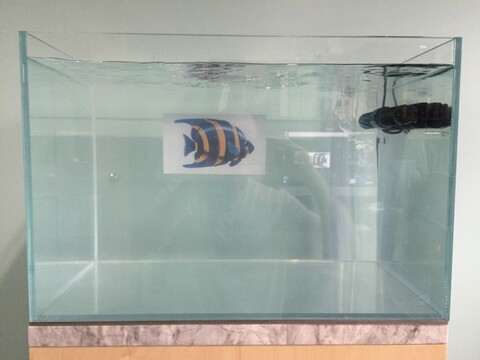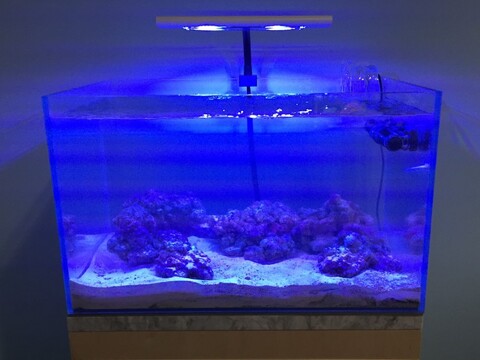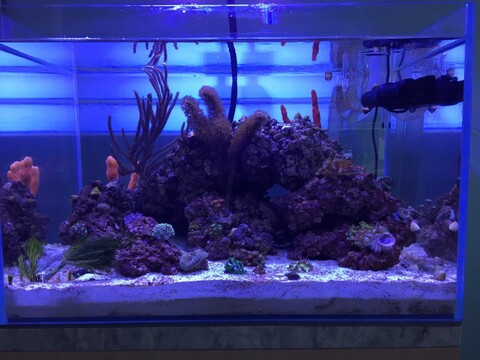The water is hazy in your new saltwater aquarium – and you haven’t even put anything in it yet… Help, what the heck is going on?
If this happens to you (like it did to me) don’t freak out – turns out it’s actually fairly common.
There are several reasons your fresh, very first batch of saltwater may turn hazy – even if you haven’t put anything into the tank yet.
Disclosure: This article contains affiliate links. When you follow a link to purchase the products, I sometimes earn a commission, at no additional cost to you. Read my full disclosure here.
3 Common Reasons for Hazy Water in a New Aquarium:
1. Bacterial Bloom
If the water is hazy in your new saltwater tank, this is most likely the cause – and don’t worry it’s quite normal and often unavoidable. It is essentially the start of your tank’s ‘cycle’.
If you’ve done even just a tiny bit of research before setting up your new tank, you most likely know your tank will have to go through a cycle in which natural bacteria enter and achieve a balance in your tank. The two primary types of bacteria involved in the cycle are heterotrophic bacteria and autotrophic bacteria.
The autotrophic bacteria are the most important of the two, They consume inorganic substances – such as the ammonia produced by decaying detritus and waste – and convert it into less harmful nitrites and nitrates. They are the biological filters of the saltwater aquarium and one of the primary reasons for having a live rock in your tank. For that reason, many people assume the cycle starts when the live rock is added.
Here’s the kicker though: It takes very little organic matter in a new tank for the cycle to start – even the oils from your skin can be enough to trigger the heterotrophic bacteria and begin a bloom.
When it happens, the water is hazy, like a drop or two of milk was put in the tank.
It happens quick – just a few hours – and can be a little unsettling. Here’s what mine looked like:

I did a lot of fidgeting with my gyre pump after putting the water in my tank. So a fair bit of oil and other microscopic organics from my hands enter the water. But I was unaware that was all it took to trigger a bacteria cycle. As a result, I wasted several hours tinkering with my return pump and testing my saltwater mix (thinking it was one of the next two culprits) before I finally realized it was a simple, common bacterial bloom.
The best way to deal with this type of bacterial bloom – wait it out. It will clear up in a couple of days once the two bacteria reach a balance. Water changes may reduce the haziness a bit, but there is no way you’ll be able to keep up with the growth/death cycle of the heterotrophic bacteria enough to keep the water clear.
My plan is simply to add my live rock in two more days as I had originally intended, let it go through its normal cycle, and all should be fine and crystal clear once it’s done. I’ll report back later to verify it’s success.
Another common culprit to look for if your water is hazy is…
2. Micro Bubbles
Your water may look silvery and cloudy if there are microbubbles present. Look close enough and you should even be able to see them.
If you are experiencing microbubbles, some potential causes to look for are:
- Excessive agitation in your sump and/or not enough space or time for the bubbles to escape the water before entering the return pump. Ensure you have enough baffles/bubble traps and slow enough flow in your sump to give the bubbles time to rise to the water surface before reaching your pump.
- Cavitation in your return pump – check to make sure your pump rotor is clean and functioning normally, and that your return pump is not grossly oversized for the amount of water you need to move.
- A small leak in your plumbing – in most cases a plumbing leak will mean water dripping out of your system. But, while very rare, it is possible in some parts of your return plumping for a leak to result in air being drawn in instead.
The next common cause of hazy water occurs when using kalkwasser or 2-part dosing for corals.
3. Calcium Precipitation
Calcium precipitation can also cause hazy, white water. When this occurs, rather than looking like a drop or two of milk was added to the water, your water will be much cloudier. It can even be so cloudy that it looks like a tank full of skim milk.
Typically this is the result of an overdose of kalkwasser. The calcium carbonate will precipitate out of the solution when pH levels get very high for an extended period of time, forming very fine white dust. When using 2-part dosing it possible for other minerals to precipitate as well – such as magnesium hydroxide.
If precipitation occurs, the most important thing to do is test your pH. If it is still over 8.6 you should use vinegar, soda water, or another means of lowering it. Afterward, just wait it out until the precipitate dissolves back into the water and clears after a few days. Then, work to re-balance your calcium levels and alkalinity. The high pH and rapid swings in alkalinity will stress the corals but they may recover.
1 Week Update: Turns out the hazy water wasn’t caused by a bacteria bloom, it was caused by a bad batch of refractometer calibration solution. You can see the quick story of this near-disaster here.
Fortunately, I caught the mistake in time, the first batch of live rock from my Tampa Bay Saltwater ‘Package’ has been added to the tank, and the cycle is progressing very smoothly – only 0.04 ppm ammonia so far!

1 Month Update: Other than the high salinity mishap, the rest of the cycle was quick and painless. Ammonia topped out at 0.40 ppm and then fell to zero within 7 days. The remainder of the live rock – plus other goodies including a rock flower anemone, sea mat, snails, sea cucumbers, two gorgonians, a peppermint shrimp, hermit crabs, and some macro-algae – were added on December 30.
Since then, I’ve introduced several corals to my reef in a box. Nitrates, pH, and alkalinity continue to hold within my desired range: NO3 is at 10-20 ppm (remember, my goal is for the tank to be slightly ‘dirty’ or nutrient/nitrate-rich), pH is 8.2, and dKH is 10.
In other words, so far, so good.




